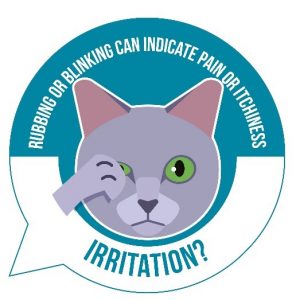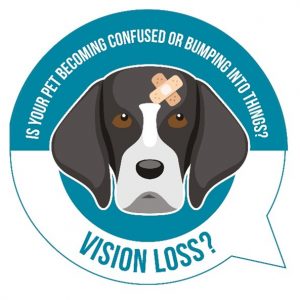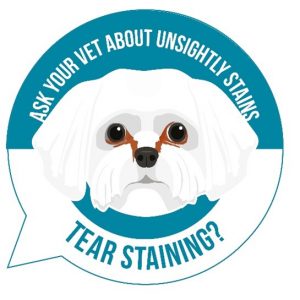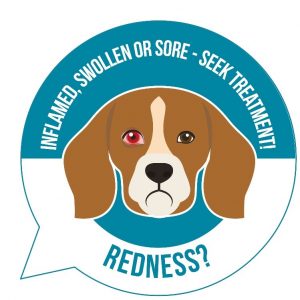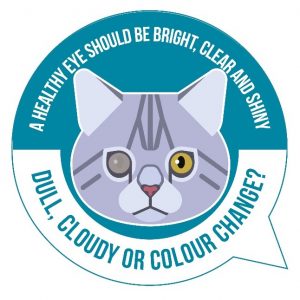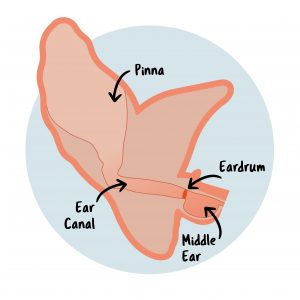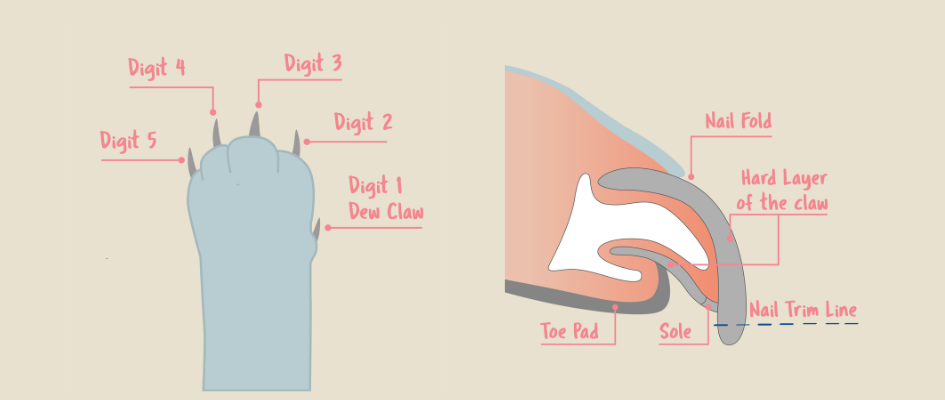Can you recognise the seven common signs of poor pet eye health? We are taking part in National Pet Eye Health Awareness Week (18-24 September) in partnership with TVM UK who have shared the most important things to look out for.
1. Asymmetry
Careful observation of the way your pet looks and acts and what is classed as ‘normal’ for them is the first critical step for responsible pet care. Regarding eye health, any perceived changes in your pet’s eyes can be a good indication of whether or not a trip to your vet is warranted. Do both eyes look like each other, are the face and head symmetrical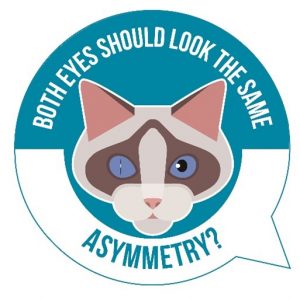 when comparing right to left?
when comparing right to left?
Useful Observations:
- Do they both look shiny and clear, not dull, cloudy, or dry?
- Are the pupils the same size and shape?
- Is one eye squinting?
- Is one eye runny with watery or sticky discharge?
- Is the colour the same? Does one look red? Has the iris suddenly changed colour?
If one eye is showing differences from the other eye or any of the above clinical signs, please get your pet checked by your vet as soon as possible.
2. Irritation
Eyes are extremely sensitive and easily irritated – did you know that the cornea has around 20-40 times more nerve endings than the tooth root? And most of us know how painful toothache is…
If you believe that your pet is suffering from eye irritation you should contact your vet for advice as irritation can be a sign of eye pain or itchiness.
Symptoms that may suggest that your pet is suffering from eye irritation:
- Pawing/rubbing at their eye/s
- Redness
- Squinting or excessive blinking
- Excessive tear staining
- Sticky or runny discharge
- Light sensitivity
- Swollen skin around the eyes
- Dullness or cloudiness of the eye
- Different pupil sizes
Some common reasons which may cause eye irritation in your pet:
- Allergies
- Conjunctivitis
- Foreign object in the eye
- Eyelid Abnormalities
- Trauma
- Corneal scratches/ulcers
- Irritants – smoke, shampoo, etc
- Dry eye (poor tear film)
Eye problems can be very painful and go from bad to worse very quickly so don’t delay in seeking advice and treatment from your vet!
3. Blindness
Like us, pets often experience gradually failing eyesight as they approach their senior years and due to compensation using their other, superior, senses like smell and hearing, gradual sight loss may not be easily noticed by pet owners.
However, there are many other conditions that can cause your pet to go blind relatively suddenly at any age, so it is important to be vigilant of sudden changes or symptoms.
Symptoms of acute eyesight loss you may notice are:
- Changes in the appearance of the eye
- Confusion/disorientation
- Clumsiness – bumping into things
- Easily startled or nervous
- Slow and cautious movement
- Getting lost outside
- Unable to find toys, food dishes, water, etc.
- Not wanting to go out at night
Conditions causing blindness are serious and need urgent treatment if there is any remaining chance to prevent total, permanent vision loss. Blindness can also be a result of many systemic diseases which can be damaging to other organ systems so it is extra important to get your pet checked and treated.
Conditions that can cause blindness:
- Tumours in the eye
- Eye injuries
- Glaucoma
- Brain disease – Aneurism, Stroke, Seizures, Tumours, or Infection
- General Disease – e.g. diabetes, hyperthyroidism
- Cataracts – more common in Miniature Poodles, Miniature Schnauzers, Cocker Spaniels, Golden Retrievers, Boston Terriers, and Siberian Huskies
- Corneal disease
- Dry eye
- Retinal Disease
- Inflammation inside the eye
4. Tear Staining
Tear stains are those reddish-brown marks that can appear on the fur around your pet’s eyes. These stains can be unsightly and noticeable, especially on pale fur.
Dog and cat tears naturally contain high amounts of porphyrins – these are iron-containing compounds derived from red blood cell breakdown in the body. When tears sit on the skin the porphyrin staining will intensify in the presence of light.
Not only that, when tears sit on the skin around the eye, they make it damp which favours local bacterial growth – some bacteria can produce their own porphyrins, therefore, contributing to tear staining.
Tear staining is more likely to occur in certain breeds where tears find their way onto the face more easily, rather than draining normally down the tear ducts. For instance, this may be due to the shape of the face, abnormalities of the tear ducts, or small hairs around the corners of the eye that wick tears onto the face.
In most cases tear staining is largely a cosmetic problem and your pet will lead an otherwise normal life, however, some patients with tear stains may have underlying eye problems which means they overproduce tears due to ocular irritation. These tears can then spill over onto the face resulting in tear staining. It is important to ensure underlying reasons for tear staining have been ruled out by a vet as, if ignored, the underlying problem may progress and be harder to treat.
5. Redness
Your pet’s eyes are as sensitive as your own and are just as susceptible to irritation, allergies, injury, and disease. One of the earliest signs of many eye problems is a red eye. If your pet’s eyes appear visibly red or swollen get them checked ASAP by your vet as some causes of a red eye are not only painful but can lead to permanent blindness if left untreated (such as glaucoma).
Common causes of redness:
- Conjunctivitis
- Allergies or irritants
- Foreign object in the eye
- Dry Eye
- Injury
- Uveitis (inflammation inside the eye)
- Corneal Ulcers
- Glaucoma
- Cherry Eye
6. Dull, Cloudy, or Colour Change
Healthy eyes should be bright, clear, and shiny — if your pet’s eye suddenly looks cloudy or opaque this is a sure sign of an eye problem that needs to be examined by a vet!
Most often cloudiness is noticed in the cornea (the clear window at the front of the eye) or the lens- vision may be affected to varying degrees depending on the underlying cause.
Conditions most likely to cause cloudy or opaque eyes:
- Cataracts
- Uveitis- inflammation inside the eye
- Pannus- autoimmune inflammation in the cornea, German Shepherds are predisposed
- Injury or damage to the eye/s
- Corneal ulcers or scratches
- Dry Eye
- Glaucoma
Nuclear Sclerosis is considered a normal ageing change in older pets where the lens takes on a cloudy or blueish haze – it doesn’t affect vision but can often be confused with cataracts at first glance. Your vet can easily distinguish between the two conditions by doing an eye exam.
7. Runny or Sticky Eye
Eye discharge is a common problem in pets. Some types are completely normal, while others may be associated with potentially serious health concerns. In order to determine when you need to take your pet to the vet, you’ll need to understand the various types of eye discharge and what each may mean.
5 most common types of eye discharge:
- A little ‘gunk’ or crustiness – generally made out of dried tears, oil, mucus, dead cells, dust, etc. Typically, clear or a slightly reddish-brown colour that accumulates at the inside corners of the eyes. Most evident in the morning and is perfectly normal, with the amount produced each day being relatively constant. It should be easily removed with a damp cloth or eye cleansing solution made for pets. The eyes shouldn’t be red and shouldn’t exhibit any signs of discomfort.
- Watery Eyes – Excessive eye watering (AKA epiphora) is associated with many different conditions that can range from being relatively minor to more serious. Below are some of the common causes of watery eyes in pets:
- Allergies
- Irritants
- Foreign body in the eye
- Anatomical abnormalities (e.g. rolled in eyelids)
- Blocked tear ducts
- Corneal wounds
- Glaucoma (increased eye pressure)
Your pet may have simply received an eyeful of pollen or dust, and the increased tearing is working to solve the problem. If eyes continue to water or your pet develops red, painful eyes or other types of eye discharge, make an appointment with your vet.
- Reddish-Brown Tear Stains – many pets, especially those with light-coloured fur, develop a reddish-brown discolouration to the fur near the inner corner of their eyes. This occurs because tears contain a pigment called porphyrin that turns reddish-brown with prolonged exposure to air. In most cases tear staining is cosmetic and can be removed with eye cleansers however sometimes it may be due to an underlying disease causing excess tearing so it is advisable to get tear stains checked by a vet.
- White-Grey Mucus – This can be a sign of Dry Eye (AKA keratoconjunctivitis sicca), a condition where the tear film becomes inadequate. A normal tear film is vital for good eye health so the body tries to compensate by making more mucus to try and lubricate the eyes. Left untreated Dry Eye can result in severe discomfort and potentially even blindness.
- Yellow or Green Eye Discharge – pets whose eyes produce yellow or green discharge often have conjunctivitis or an eye infection.
If you have any concerns, get in touch with your local Goddard vet for advice, or make an appointment online.

 when comparing right to left?
when comparing right to left?